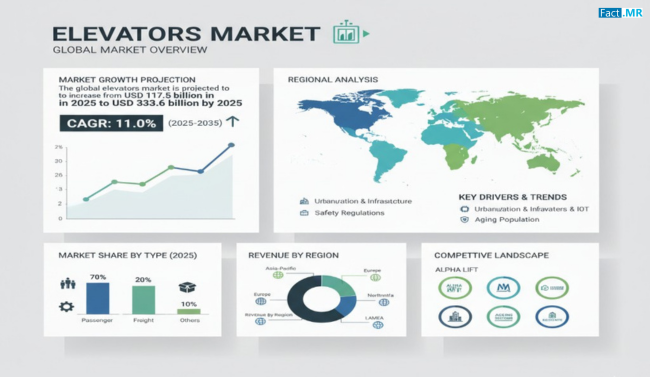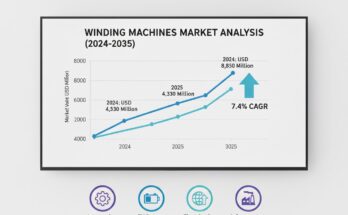As cities continue to grow vertically, elevators have become an indispensable part of modern infrastructure, enabling efficient movement within residential, commercial, and industrial buildings. The elevators market is evolving rapidly, driven by advancements in urbanization, sustainability goals, and technological innovation. From high-rise apartments to smart city projects, elevators now represent far more than a convenience—they’re a crucial component of energy efficiency, safety, and accessibility in next-generation buildings.
Market Overview
The global elevators market is witnessing strong momentum as industries and governments focus on improving building efficiency, safety standards, and mobility solutions. With the surge in construction activities across urban centers, there’s a growing demand for intelligent and sustainable elevator systems designed to optimize performance and reduce operational costs.
Manufacturers are developing advanced elevators that integrate predictive maintenance, energy-efficient motors, and digital monitoring systems. This evolution reflects a broader transformation toward connected, data-driven infrastructure that enhances both convenience and sustainability. Furthermore, as aging buildings undergo modernization, retrofitting of old elevators with digital control systems and eco-friendly components has become a key market trend.
Regional Insights
Asia Pacific stands as a key region in the global elevators landscape, supported by large-scale urbanization, population growth, and ambitious smart city initiatives. Countries such as China, India, and Japan are investing heavily in new construction and modernization projects, creating significant opportunities for elevator manufacturers and maintenance providers.
Europe continues to focus on sustainability and safety compliance, prompting widespread adoption of energy-efficient elevator systems. Upgrades in older building structures, combined with regulatory emphasis on accessibility for the elderly and differently-abled, are driving regional demand.
North America is characterized by growing investments in intelligent building technologies and retrofitting programs, particularly in urban areas. Meanwhile, the Middle East & Africa region is emerging as a growing market with high-rise commercial projects and tourism-driven developments boosting elevator installations.
Key Trends & Forecast
The elevators market is being reshaped by multiple technological and consumer-driven trends that define the future of vertical mobility:
- Smart and Connected Elevators:
The integration of IoT and AI technologies is enabling real-time data analysis, predictive maintenance, and remote monitoring. Smart elevators can predict component failures, optimize energy use, and enhance passenger safety through advanced analytics. - Energy Efficiency and Sustainability:
Eco-friendly elevators featuring regenerative drives, LED lighting, and standby modes are gaining traction as building developers aim to meet green certification standards. The shift toward sustainable infrastructure is reinforcing the demand for low-energy vertical transportation systems. - Touchless and Hygienic Solutions:
Post-pandemic hygiene concerns have accelerated the development of contactless elevator technologies, including voice-activated controls, mobile-based calling, and UV-based disinfection systems, ensuring safer passenger experiences. - Modernization and Retrofitting:
With many aging buildings across developed economies, modernization remains a key growth driver. Upgrading outdated elevator systems with smart controllers, advanced braking systems, and improved cabin designs enhances performance, comfort, and compliance with evolving safety standards. - Focus on Design and Passenger Experience:
Elevator design has transcended functionality—today, aesthetic appeal, digital displays, ambient lighting, and smooth operation are seen as crucial differentiators in luxury and commercial properties. - Rise of Destination Control Systems:
Destination dispatch technology allows elevators to group passengers going to the same floor, reducing waiting and travel time while improving overall building efficiency—particularly in high-density commercial environments.
Applications & End-Use Outlook
Elevators play a vital role across multiple sectors, each contributing uniquely to market expansion:
- Residential Buildings:
Urban population growth and the rising number of high-rise residential complexes are fueling the installation of efficient and space-saving elevators. In many developing economies, affordable housing projects are increasingly incorporating basic elevator solutions to improve accessibility. - Commercial and Office Spaces:
As business hubs expand vertically, commercial buildings require faster, smarter, and more reliable elevators capable of handling heavy passenger traffic. Destination control systems and intelligent access management are becoming standard in modern office towers. - Industrial and Infrastructure Projects:
Elevators designed for industrial use—such as freight and service lifts—are critical in warehouses, manufacturing plants, and transport facilities. Infrastructure developments like metro stations and airports also rely on durable and high-capacity elevator systems. - Healthcare and Hospitality:
Hospitals and hotels require elevators that ensure smooth and silent operation, often customized for stretcher handling, accessibility, and luxury service standards. This has prompted manufacturers to develop specialized models catering to these sectors.
Competitive Landscape
The global elevators market features a mix of global giants and regional players competing through innovation, partnerships, and service excellence. Leading companies are emphasizing digital transformation—integrating IoT platforms and AI-driven analytics into elevator management systems. Strategic collaborations between elevator manufacturers, construction firms, and technology providers are helping accelerate the transition toward intelligent mobility ecosystems.
Moreover, service and maintenance have emerged as critical revenue streams. Continuous maintenance contracts, remote monitoring, and modernization services are allowing brands to strengthen customer relationships and enhance long-term reliability. Companies are also expanding their presence in emerging markets, where urban infrastructure projects continue to flourish.
Future Outlook
As the world transitions toward smart cities and green architecture, elevators will play a defining role in shaping sustainable urban mobility. The growing convergence of digital technology and engineering excellence is set to revolutionize how elevators operate—making them faster, safer, and more responsive to user needs.
Future innovations are expected to include AI-powered predictive analytics, energy-harvesting elevator systems, and multi-directional movement technologies that can redefine vertical transportation. Governments and industry stakeholders are also likely to collaborate on creating unified safety and performance standards that ensure both efficiency and inclusivity.
Conclusion
The elevators market stands at the intersection of technology, sustainability, and urban transformation. With the global focus on smart infrastructure, the evolution of elevators is moving beyond vertical mobility to represent a broader vision of connected, intelligent, and energy-efficient living. For developers, architects, and policymakers, adopting advanced elevator technologies is not just an operational choice—it’s a step toward building the cities of the future.
Browse Full Report – https://www.factmr.com/report/408/elevators-market



